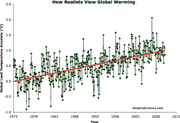Why are there fewer weather stations and what's the effect?
What the science says...
| Select a level... |
 Basic
Basic
|
 Intermediate
Intermediate
| |||
|
Dropped stations show more warming than kept stations. |
|||||
Climate Myth...
Dropped stations introduce warming bias
'Two American researchers allege that U.S. government scientists have skewed global temperature trends by ignoring readings from thousands of local weather stations around the world, particularly those in colder altitudes and more northerly latitudes, such as Canada.' (Vancouver Sun)
An oft-cited skeptic argument is that the decrease in available temperature measuring stations during the 1990s introduces an increased bias towards warming. The argument is based upon the premise put forward by some climate change skeptics that stations which show more warming were kept and ones that show less warming were dropped. The reason this assumption is made is because during the 1990s there was a large reduction in the number of meteorological stations being used for global temperature analyses.
In order to test this theory, several independent researchers (Tamino, Ron Broberg, Zeke Hausfather, Joseph at Residual Analysis and others at the Clear Climate Code Project) and have calculated whether the stations dropped showed less warming than the ones kept. The results? Several find no difference and several find that dropped stations show more warming.
Furthermore, it is also important to note that the methods used in global temperature analyses make them robust to the loss of stations because they use techniques which incorporate multiple nearby stations into analysis of any individual region.
So to conclude: Independent researchers have shown that there is no truth to the claim that cooling stations were removed, in fact evidence suggests that if these stations were included, warming would be shown to be slightly greater.
Last updated on 23 October 2016 by robert way. View Archives































 Arguments
Arguments



































This reminds me of an allegtion I saw on You-tube saying there was no global warming .. it was made by a deputante at some Congressional Hearing and it was that NASA had started to include the ocean data after WWII only because it was higher and without that there would be no warming. The "evidence" for this was buttressed by satellite data which the deputante alleged was the correct data. I am aware of the problems with satellite data, but what's the story with NASA alledgedly starting to include ocean data after WW II? As a suppmentary question I have always been unsure whether the "Ocean" in Global Mean Surface Temperature based on Land and Ocean means the air about a metre above the surface as it does for land, i.e. taken from small islands, buoys and ships, or is it the the temperature of the ocean water at the surface? I have noticed different graphs showing "Sea Surface Temperature", and am confused about the relationships of all of these. Some simple clarification by staff would be greatly appreciated.
Some link to the allegations would be useful because this doesnt make any sense. Sea water temperature changed around WW2 from canvas bucket to engine inlet. Unadjusted, this make warming trend look higher than actual so NASA has adjusted data to account for that which reduces the warming trend. SST is certainly used before WW2. And yes, it surface sea temperature. Defining 1m above sea on surface in motion would be tricky. Sea doesnt have same temperature issues close to surface as land.
You might want to look at this article and comment further there as your question is offtopic here.